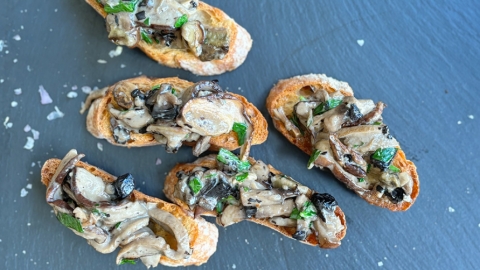Spreading a Love for Fungi
Late summer marks the peak of mushroom season—the most wonderful time of the year in Arizona—if you’re a mushroom forager. Mushrooms can be found throughout the state year-round but come into full swing with the monsoon’s arrival. When foraged fresh, they can be dried and stored for months to come and used for fall’s cooler-weather cooking.
The Arizona Mushroom Society (AMS), a state affiliate of the North American Mycological Association, is an event-based educational organization that has served mycology enthusiasts for decades.
Mike Dechter is executive director of the AMS. He’s served in numerous roles since joining around 2007 and has helped organize events and forays since 2016. One of their largest events is the annual foray and festival, held in Alpine, AZ, every August, where members can learn how to forage, identify and cook wild mushrooms.
AMS was born from an earlier iteration known as the Arizona Mushroom Club started by Chester Leathers, a professor of microbiology at Arizona State University. Dechter said they had a small but loyal following throughout the 1980s into 2015, when the club was renamed and attained nonprofit status. The organization has steadily increased membership and utilized grants for educational programming, events and funding for the Dr. Chester Leathers Graduate Student Scholarship, awarded annually to a student who is undertaking research in mycology or a related field in or related to Arizona.
Describing most members are enthusiasts and amateur mycologists who do not have a specific mycological background, Dechter said, but they are self-driven to learn about mushrooms. He says many enjoy exploring outdoor fungi habitats and foraging wild mushrooms to cook and eat. Scott Bates, a mycologist who studied under Chester Leathers, remains a standing member of the all-volunteer board and helps to advise.
Dechter attributes increased interest around fungi to the internet and social media and also to new tools and technology for citizen scientists, such as iNaturalist, an app where users can upload photos and have expert mycologists from around the country identify species.
“Back in the day when I started, if you wanted to know what a mushroom was that you found on the ground, it would be very difficult to do,” he said.
Not only was identification more difficult, but a mushroom was more likely to be called a well-known European species because DNA sequencing was not as readily available. Now, Dechter said citizen scientist and AMS member Terri Clemens has sequenced up to a thousand different specimens with help from the organization.
“Seventy percent of what we DNA sequenced has never been described by science before,” he said. “They have a unique DNA sequence, so a lot of these [mushrooms] we don’t even have names for.”
Still, there are what Dechter calls “the fab four”—the most easily identifiable of Arizona mushrooms. They include lobster mushrooms, which grow in Ponderosa pine forests and are recognized by their bright orange color; shaggy mane, a species found in urban areas in packed, decomposing organic matter; puff balls, which release a cloud of spores when disturbed; and Aspen boletes, with their characteristic scab-like pattern on the stem.
There are also rarer species that grow in unique habitats. The candy apple bolete, also called Frost’s bolete, are limited to oak populations found in “sky islands,” the name for isolated mountain ranges with greater biodiversity than the surrounding area, as well as in Oak Creek Canyon north of Sedona.
According to Dechter, these oak populations formed after the last Ice Age and are more common in the southern U.S., where the brightly colored and edible boletes can also be found. He refers to them as a “relic species”—organisms with widespread distribution in a previous epoch.
“It has a bright red cap that’s shiny; it has red gills and a crazy reticulated stem. You’ve got to look this thing up on the internet. It’s unbelievable,” he said.
The AMS has hosted an event with the American Truffle Association, featuring a presentation identifying potential truffle-growing areas in Arizona. Tuberous underground fungi are highly prized for their nutty, pungent flavor, the two most popular varieties are white truffles from northern Italy’s Piedmont region and black Perigord truffles from southern France.
Because they are scarce, seasonal and difficult to cultivate, truffles are known to fetch exorbitant prices and are often served fresh, thinly shaved over pasta dishes or infused into butter. It’s an exciting prospect that Arizona could have the necessary conditions for wild varieties.
For the experienced and newcomers alike, it’s important to follow a set of safe practices when foraging for wild mushrooms. The first, Dechter said, is to be certain about your identification. Googling photos to cross reference is helpful, but confirming with an expert is ideal. Visit iNaturalist and the AMS Facebook group page, where anyone can upload a photo of a mushroom for identification.
It is also helpful to use additional factors to aid in accuracy, such as details of the mushroom’s entire anatomy along with the stem and gills. Changes in color when cut open—known as “bruising”—are the result of certain chemical compounds interacting with oxygen and are a notable characteristic in differentiating between certain edible and non-edible species. Other plants or trees found in the surrounding environment near the mushroom are also useful indicators.
Practicing a “leave no trace” policy is important, Dechter said. Foragers need to know any specific rules or if permits are required, which may change depending on if you’re picking in a national forest or on state or BLM land. Luckily, foraging wild mushrooms has little environmental impact, since what is gathered is the fruiting body of an underground organism that doesn’t decrease the abundance over time.
“The best thing to do,” Dechter said, “is be light on the land itself and harvest, but don’t leave a trace.”
Visit the Arizona Mushroom Society’s website at arizonamushroomsociety.org to learn more about becoming a member or find info on future educational and in-person events.






